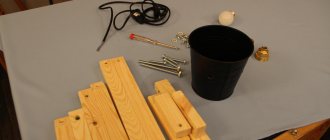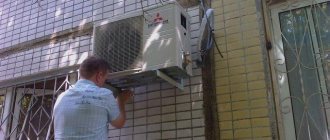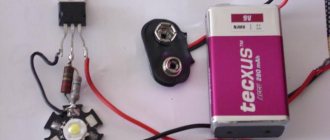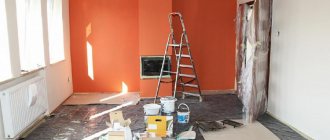Drawing up a wiring diagram
Let's make a reservation right away: we are talking about a single-phase network with a voltage of 220 volts, which is already connected to a private house with an area of 100-150 m² or an apartment. Specialized organizations are engaged in the design and installation of three-phase 380 V electrical networks for large country cottages. In this case, it makes no sense to take on the electrical wiring yourself, since without a power supply project and agreed-upon as-built documentation, the management company will not allow you to connect to its communications.
So, the typical electrical wiring diagram for a residential building shown above includes the following elements (starting from the cable entry):
- input circuit breaker rated 25 amperes;
- electric meter (preferably multi-tariff);
- residual current device - RCD, designed for an operating current of 300 mA;
- a 20 A differential circuit breaker, triggered at a leakage current of 30 mA, to protect the socket network;
- automatic switches rated 10 A for lighting (the number depends on the number of lines to the lamps);
- electrical cabinet equipped with a neutral and grounding bus, as well as DIN rails for mounting automatic machines and RCDs:
- cable lines with distribution boxes leading to sockets for connecting household appliances and lighting fixtures.
Note. According to the PUE, the power supply to a bathroom, bathhouse, sauna and other rooms with high humidity must be provided by a separate line, protected by an RCD or a circuit breaker with a response threshold of 10 mA.
The functional purpose of the listed elements is as follows. Circuit breakers protect branches or the system as a whole from short circuits, RCDs protect you from electric shock, and a differential circuit breaker combines these 2 functions. The latter must be installed on each power line. To protect household electrical appliances from voltage surges, you can supplement the circuit with a protective relay installed after the main RCD, as the master explains in the video:
To make a complete electrification scheme, you need to draw a house plan by hand and place lighting fixtures with sockets on it. Indicate the location of the electrical panel and spread the wiring from it along the walls, marking each pair (phase and zero) with one line, as electricians do (called a single-line diagram). An example of such a sketch is shown in the picture.
Reference. In private houses and cottages, the switchboard is usually installed in a technical room, for example, in a garage, sometimes in the corridor. The same picture is observed in multi-storey new buildings. In Soviet-era houses - "Khrushchev" and "Czech" - apartment panels were massively installed in the entrances, but then the owners began to move them to their hallways in order to protect themselves from theft of meters.
Electrical wiring in the apartment - European version
Let me note right away that this is the most expensive and time-consuming wiring option. The European version of electrical wiring is possible if you have an apartment electrical panel installed. It is sometimes called star wiring or boxless wiring.
Related articles: Malfunction of the circuit breaker in the panel
Its essence is as follows. All power sockets in the apartment are powered by separate electrical cables from the apartment electrical panel. The circuit breaker for each electrical wiring line is separate.
- The advantages of such wiring are high reliability and safety, ease of maintenance.
- Disadvantages: high cost, large electrical panel, high labor intensity.
Preparation of materials
To purchase the necessary installation materials and determine their quantity, take the completed electrical diagram as a basis. The control, protection and metering elements located in the panel are already indicated on it; all that remains is to select cable products and socket boxes (switches and sockets themselves can be purchased later). The recommendations in this regard are:
- For electrical wiring, use copper cable brand VVG with 3 solid cores and its varieties. Do not use aluminum or stranded wires (for example, PVA) intended for other purposes.
- Copper electrical wiring in an apartment or private house that powers lighting fixtures must have a minimum cross-section of 1.5 mm². The socket network must be made with a 2.5 mm² cable, and the connection of the ground loop must be made with a cross-section of 6 mm².
- If it is necessary to draw an external line from a pole to a building, use a 16 mm² self-supporting SIP wire and special hanging brackets.
- For hidden cable routing, use a metal hose or a plastic corrugated pipe of the appropriate diameter (the wires should occupy no more than 40% of the cavity of the protective sleeve), fixed with latches or clamps.
- Do not provide many single indoor sockets in different places; it is better to place a couple of blocks with 4-5 plugs. For the kitchen, one group of 5 sockets is sufficient.
- The number of junction boxes is calculated according to the diagram below, which shows the correct installation of wiring. The box is placed on each branch from the main line.
Advice. For power lines loaded with installations with a power exceeding 3.5 kW, the cable cross-section should be selected according to calculation. We recommend that you resolve this issue with specialists, since the introductory machine and other equipment will also have to be selected individually and you cannot do without a power supply project.
Before calculating the quantity of cable products, consider the method of laying the electrical wiring. The best option is to route the conductors behind the ceiling and wall sheathing made of plasterboard, in the floor or under the baseboard. This approach will protect communications from damage during subsequent repairs and can be easily implemented in one-room and two-room apartments in panel houses.
In wooden houses built from timber or using frame technology, internal wiring of an open type is practiced - on insulators or in plastic channels, as done in the photo. In this case, it is more convenient to lay a network using a flat type of cable - VVG-P. Don’t forget about low-current lines - twisted pair for the Internet, alarms, and so on, they also need to be routed between rooms.
It is also worth mentioning the retro-style electrical wiring, which harmoniously fits into the interior of any wooden home, including a log home. But keep in mind that the price of components is three times higher than conventional materials, and the installation method shown in the video requires some skills.
Electrical wiring in the apartment. Do-it-yourself wiring in the apartment. Electricity in the apartment.
Did you like the video? Subscribe to our channel!
The first sign that makes you think about replacing the wiring in your apartment is that the plug of the appliance you just purchased does not fit into your old socket installed many years ago. Then the circuit breaker starts to trip due to the increased load, and you have to think - what should I use the dishwasher or washing machine now? Well, when the sockets and wiring begin to smell of burnt plastic, it becomes clear that it’s time to change the electrical wiring in the apartment. Replacement of electrical wiring in the apartment must be carried out before finishing work or during it, since cable installation requires drilling walls and cutting channels for cable laying. The easiest option is to find a team of electricians who will install the wiring in the apartment. Another option is to do everything yourself. Don't be afraid of electrical work. They can be performed by anyone who has the skills to work with the tool. This option may also be preferable because it is often impossible to repair electrical wiring in the entire apartment at once - it has to be done gradually, and construction crews are reluctant to take on small amounts of work. So, you have decided to replace the wiring in your apartment on your own. What will you need? 1. Tools: • Hammer drill (it’s almost impossible to do without it). Leave the hammer drill for small jobs. Preference should be given to models with three modes - “rotation”, “rotation with impact”, “impact without rotation”. If you don’t have a hammer drill, you’ll have to buy or rent one. • A set of attachments for a rotary hammer - drills (you will probably need 6 mm, 10 mm, 20-22 mm drills), a 65 mm bit for making holes for sockets and switches, a conical chisel, a flat chisel, a chisel for grooves. • It is advisable to have a wall chaser or an angle grinder, but often a hammer drill is sufficient for grooves • A set of tools (screwdrivers, pliers, knife, wire cutters, hacksaw, scissors, etc.) • A drill, or better yet, a screwdriver. Almost everyone has a drill, but a screwdriver is more convenient to work with. • A voltage indicator screwdriver; it is advisable to have a tester for checking the continuity of wires and contacts. 2. Project of electrical wiring in the apartment (you will have to develop it yourself or we can help you with this). It is advisable to immediately determine the connection points of the main consumers. Electrical wiring in an apartment can be divided into several stages: • Drawing up a wiring diagram in the apartment; • Connections to the access electrical panel. Installation and connection of the apartment panel. Wiring from the panel.; • Connecting sockets; • Connection of switches; • Oven connection; • Connecting an electric stove; • Connection of an infrared bath; • Installation/laying of heated floors; • Connecting a chandelier; • Connecting lamps; • Internet wiring. Wiring for sockets and other consumers is recommended to be done with a single-core copper three-wire cable in double insulation (one layer of insulation on the wires and all three wires in general insulation). You should not skimp on the second layer of insulation, since slight damage to the insulation can lead to a fire if water gets on the cable during a domestic flood. It is recommended to conduct the main wiring with a cable with a cross-section of 2.5 mm2 (for example, VVG or VVGp 3x2.5 cable). This cross-section is sufficient to connect most household appliances. An exception to this rule is kitchen wiring; it is recommended to use a 4 mm2 cable, since there are many powerful electrical appliances in the kitchen - electric kettle, microwave, coffee maker, dishwasher, refrigerator and others. Lighting wiring in an apartment can be done with a double-insulated cable with a cross-section of 1.5 mm2 (VVG or VVGp 2x1.5). If wiring is carried out inside cable ducts or plasterboard walls, or behind a false ceiling, you should use a flame retardant cable (with the index “ng”). For example VVGng or VVGng-p. It's even better to use a cable with the index "ls". This cable (VVGng-LS or VVGng-LS-p) is entirely made of non-flammable plastic and has low smoke and gas emissions in case of fire. It is advisable to lay the entire cable in a corrugated tube (corrugated pipe). We will try to give you all the necessary recommendations for electrical wiring in the apartment. Select the appropriate item in the above list of works to become more familiar with the object of interest. For any questions you may have regarding electrical wiring in your apartment, you can contact our company employees or use the “Question-Answer” section.
Minimum tool kit
To install or replace electrical wiring with your own hands, you will need the following set of tools:
- grinder with circles on concrete for making furrows in brick or plastered walls;
- a hammer and chisel to cut out the nests of socket boxes;
- nippers, pliers;
- tape measure and building level;
- narrow metal spatula;
- screwdrivers with various slots;
- cable cutting knife.
Advice. Instead of a regular knife, it is better to use a special tool, a sample of which is shown in the photo. It is equipped with a small heel at the end, which allows you to strip the insulation from the wires without damaging the copper conductors and is safe for your hands.
Wiring by branching in junction boxes
Wiring in an apartment using branches in junction boxes remains a favorite option for builders. Cheap and cheerful. Junction boxes are also called branch boxes or distribution boxes.
The essence of this method is as follows. The electrical circuit of the entire apartment is divided into groups. Each group is also protected by a circuit breaker. From the circuit breaker, the electrical cable is laid to the so-called junction box.
Wires (cables) from all sockets of the group are supplied to the same box. In the junction box, the wires of the group are connected (unsoldered). Wiring is the connection of the same type of wires of all cables of the junction box. The word desoldering has developed historically and this does not mean that the wires actually need to be soldered. In addition to twisting and soldering, you can use special terminal blocks. You just need to choose the right terminal blocks so that they can withstand the power of the connected group.
Electrical panel installation
As a rule, this important stage of work is performed by a specialist – an electrician. But in a small residential or country house with several rooms, you can solve the problem yourself if you follow the step-by-step instructions:
- Secure the box to the wall near the cable entry. Installation height – 1.5 m above the floor. If necessary, hollow out a recess in the wall.
- Place DIN rails for mounting the machines and 2 busbars for connecting the neutral (N) and ground (PE) wires. Lead the external cable through the hole, cut it and connect the “zero” to the bus. Repeat this action with the grounding conductor.
- Secure the RCD, meter and all machines. Connect the neutral and phase from the power cable to the contacts of the input packet.
- Carry out internal wiring according to the diagram, using insulated single-core wire with a cross-section of 6 mm². For reliable contact with the terminals of circuit breakers, place special fork-shaped tips on the exposed wires.
Advice. When installing conductors, observe the color markings indicating their identity. The neutral line is indicated in blue, grounding is yellow-green, and the phase is most often brown, black or red.
When purchasing and installing a cabinet for an electrical panel, you also need to take care of the placement of backup circuit breakers, which may be useful later. Therefore, there should be 3-4 free slots on the rail. All the nuances of assembling this important organ are described in the video:
How to install wiring
In past times, electrical networks were laid along the walls before applying the plaster layer and secured with alabaster mortar. Now other methods are used for installation, namely, installation in gates 2 cm deep, cut into plaster or aerated concrete. The technology is like this:
- Using a level and a tapping cord, mark the route of each line, starting from the electrical panel. Remember that hidden electrical wiring in the house must run strictly vertically and horizontally, and turn at right angles. Mark the installation points for sockets and switches.
- Make grooves along the markings, observing the width of the groove for a single wire - 2 cm. Cut out recesses for socket boxes and distribution boxes.
- Install socket boxes and boxes on dowels or alabaster mortar. Try to maintain a horizontal line so that the sockets stand level. Do not forget to cut technological openings on the sides for cable entry.
- Treat the gates with a primer and place pre-measured pieces of cable in them and bring its ends inside all the boxes. The conductors are fixed in the groove with a solution or special spacers at intervals of 40 cm.
- Separate the ends of the wires in junction boxes and perform color wiring using WAGO terminal blocks or other available methods.
- Bare the wires in the socket boxes, put lugs on them and connect them to sockets and switches.
- Check the functionality of each line with a multimeter, then connect it to the panel and seal the grooves.
Important point. The lighting wiring is connected as follows: blue wire (N) - to the zero bus, yellow-green (PE) - to the ground bus, the remaining conductor - to the machine. The phase and neutral from the socket network are connected to contacts 1 and 2 of the differential circuit breaker, the grounding is connected to its bus.
Proper installation of wiring involves laying it according to the rules - with indentations from the floor, ceiling and doorways indicated in the drawing. In the distribution boxes of the socket group, the conductors are switched by color, in the lighting group - in this order:
- zero passes the switch and is immediately supplied to the lamp (to the contact adjacent to the lamp base);
- the phase wire goes through the switch, and then to the lighting fixture;
- the ground is connected directly to the corresponding contact of the lamp.
A pair or three pass-through switches are connected to each other and to the power cable according to a different circuit. This is discussed in detail in the corresponding publication. Watch a training video on the topic:
Marking
Before you start cutting walls for laying cables, you need to make markings, i.e. draw on the walls the places where there will be sockets, switches and wire routes. The wiring to sockets and switches must be done from top to bottom - from the ceiling to the floor.
Sometimes, due to the peculiarities of the structure of the house, electrical points have to be shifted, for example, if it (or a groove to it) falls on a concrete wall, a laid piece of reinforcement, possible communications, etc., which is why marking is so important.











